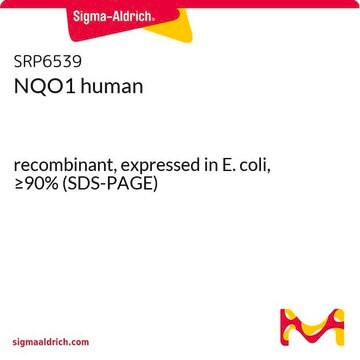F1392
Riboflavin 5′-monophosphate sodium salt hydrate
suitable for electrophoresis, suitable for acrylamide photopolymerization, ≥70%, powder
Synonym(s):
FMN-Na, Flavin mononucleotide, Riboflavin 5′-phosphate sodium salt
Sign Into View Organizational & Contract Pricing
Select a Size
All Photos(2)
Select a Size
Change View
About This Item
Empirical Formula (Hill Notation):
C17H20N4NaO9P · xH2O
CAS Number:
Molecular Weight:
478.33 (anhydrous basis)
Beilstein/REAXYS Number:
4106529
EC Number:
MDL number:
UNSPSC Code:
41106305
PubChem Substance ID:
NACRES:
NA.51
Recommended Products
Quality Level
assay
≥70%
form
powder
optical activity
[α]20/D +37 to +42°, c = 1.5 in 5 M HCl(lit.)
technique(s)
electrophoresis: suitable
solubility
H2O: soluble 50 mg/mL, clear, orange
ε (extinction coefficient)
12.5 at 445 nm at 1 mM
suitability
suitable for acrylamide photopolymerization
foreign activity
Protease, none detected
storage temp.
−20°C
Looking for similar products? Visit Product Comparison Guide
Related Categories
Application
Riboflavin 5′-monophosphate sodium salt hydrate or FMN is suitable:
- to study its mechanism of inhibition of mutagenicity of a benzo[a]pyrene 7,8-diol 9,10-epoxide, a carcinogenic metabolite of benzo[a]pyrene
- along with flavin adenine dinucleotide for reactivation of the enzyme that catalyzes the oxidation of pyridoxamine to pyridoxal in a study
- to study the reduction of polymeric azo and nitro dyes by intestinal bacteria
- to study the effect of FMN on ferrisiderophore reductase activity in the cytoplasmic fraction of Agrobacterium tumefaciens.
Biochem/physiol Actions
FMN is a coenzyme synthesized from riboflavin (vitamin B2). It acts as a component of complex I of the electron transport chain. The enzymes containing FMN are called as flavin enzymes and are involved in oxidation-reduction mechanisms.
FMN is suitable as a photopolymerization reagent in polyacrylamide gel electrophoresis (PAGE) by forming free radicals in aqueous solution in the presence of light. FMN photodecomposes to leucoflavin. No free radicals are formed in the absence of oxygen, but traces of oxygen allow for leucoflavin to reoxidize with free-radical generation. The catalysts, tetramethylethylenediamine (TEMED) or 3-dimethylaminopropionitrile (DMAPN), are commonly added to speed up the free radical formation. Free radicals will cause acrylamide and bis-acrylamide to polymerize to form a gel matrix which can be used for sieving macromolecules. FMN is commonly used in the stacking gel for non-denaturing PAGE because native proteins can be sensitive to persulfate ions from ammonium persulfate. Another advantage of FMN over ammonium persulfate is that it will not start polymerizing until the gel is illuminated.
FMN is suitable as a photopolymerization reagent in polyacrylamide gel electrophoresis (PAGE) by forming free radicals in aqueous solution in the presence of light. FMN photodecomposes to leucoflavin. No free radicals are formed in the absence of oxygen, but traces of oxygen allow for leucoflavin to reoxidize with free-radical generation. The catalysts, tetramethylethylenediamine (TEMED) or 3-dimethylaminopropionitrile (DMAPN), are commonly added to speed up the free radical formation. Free radicals will cause acrylamide and bis-acrylamide to polymerize to form a gel matrix which can be used for sieving macromolecules. FMN is commonly used in the stacking gel for non-denaturing PAGE because native proteins can be sensitive to persulfate ions from ammonium persulfate. Another advantage of FMN over ammonium persulfate is that it will not start polymerizing until the gel is illuminated.
Riboflavin 5′-monophosphate or Flavin mononucleotide (FMN) serves as a prosthetic group for flavoenzymes. It is a part of the mitochondrial respiratory chain complex I and acts as a redox carrier. FMN is unstable in alkaline solution and is highly stable at pH 6.
Storage Class
11 - Combustible Solids
wgk_germany
WGK 1
flash_point_f
Not applicable
flash_point_c
Not applicable
ppe
Eyeshields, Gloves, type N95 (US)
Choose from one of the most recent versions:
Already Own This Product?
Find documentation for the products that you have recently purchased in the Document Library.
Customers Also Viewed
J S Lodge et al.
Journal of bacteriology, 149(2), 771-774 (1982-02-01)
Reduction of the iron in ferriagrobactin by the cytoplasmic fraction of Agrobacterium tumefaciens strictly required NaDH as the reductant. Addition of flavin mononucleotide and anaerobic conditions were necessary for the reaction; when added with flavin mononucleotide, magnesium was stimulatory. This
A W Wood et al.
Proceedings of the National Academy of Sciences of the United States of America, 79(17), 5122-5126 (1982-09-01)
Riboflavin 5'-phosphate (flavin mononucleotide; FMN) inhibits the mutagenicity of (+/-)-7 beta, 8 alpha-dihydroxy-9 alpha, 10 alpha-epoxy-7,8,9,10-tetrahydrobenzo[a]pyrene (B[a]P diol epoxide), the only known ultimate carcinogenic metabolite of benzo[a]pyrene. Coincubation of 10, 25, and 50 nmol of FMN with strain TA100 of
J P Brown
Applied and environmental microbiology, 41(5), 1283-1286 (1981-05-01)
The O(2)-sensitive reduction of high-molecular-weight aromatic azo and nitro dyes by intestinal bacteria appears to be mediated by low-molecular-weight electron carriers with E(o)' = -200 to -350 mV. This process may allow the design of polymeric azo prodrugs for specific
Matthias Mack et al.
Applied microbiology and biotechnology, 71(3), 265-275 (2006-04-12)
Flavins are active components of many enzymes. In most cases, riboflavin (vitamin B(2)) as a coenzyme represents the catalytic part of the holoenzyme. Riboflavin is an amphiphatic molecule and allows a large variety of different interactions with the enzyme itself
Steven O Mansoorabadi et al.
The Journal of organic chemistry, 72(17), 6329-6342 (2007-06-22)
Flavin coenzymes play a variety of roles in biological systems. This Perspective highlights the chemical versatility of flavins by reviewing research on five flavoenzymes that have been studied in our laboratory. Each of the enzymes discussed in this review [the
Our team of scientists has experience in all areas of research including Life Science, Material Science, Chemical Synthesis, Chromatography, Analytical and many others.
Contact Technical Service




